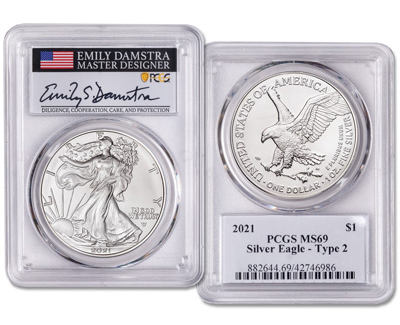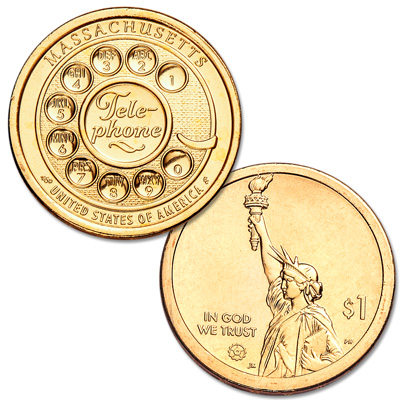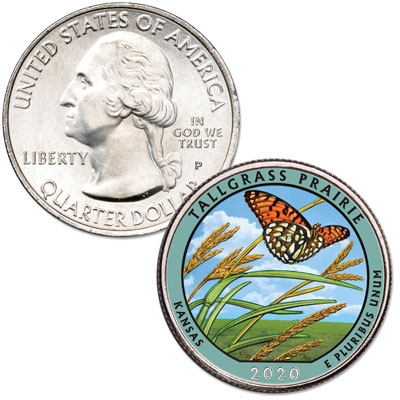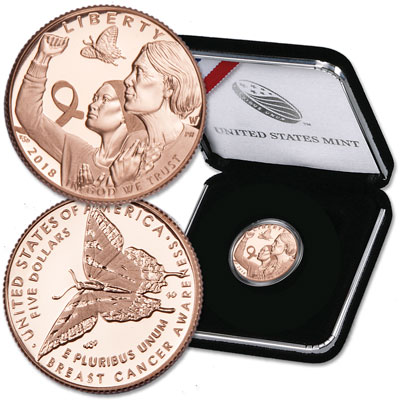Bald Eagle, Regal Fritillary Butterfly, Sassafras and a Rotary Dial Telephone: Collecting Emily Damstra
No doubt about it: Since its July debut, the Type 2 American Silver Eagle dollar continues to generate high interest with its new, realistic reverse motif on the world’s most popular bullion. Let’s take a look at its designer, Emily S. Damstra, and see what else is in her numismatic portfolio.
For a little perspective, Damstra’s work for the U.S. Mint puts her in the company of four other accomplished women designers. Probably the most well-known is the late Glenna Goodacre, whose groundbreaking mother-and-child design of Sacagawea and her infant son in 2000 became the standard obverse for the Native American dollar coin.
Similarly, Damstra’s design that shows a landing eagle with talons holding a symbolic oak branch – America’s national tree – inaugurates a new era for another long-running coin.
“You can see by looking at an eagle all of the values and traits that we associate with it – strength, dignity, majesty, and liberty,” Damstra said in an interview with mint. “Eagles are my favorite symbol because they are a symbol from nature.”
Since 2003, Damstra has been part of the mint’s Artistic Infusion Program (AIP). The initiative aims to invigorate the designs of U.S. coins and medals from American artists with diverse backgrounds and a variety of interests. Damstra’s comes with a masters of fine arts degree in science illustration from the University of Michigan. With dual citizenship in the U.S. and Canada, Damstra has, to date, designed more than a dozen coins and medals for both the U.S. and the Royal Canadian Mints.
Interestingly enough, Damstra’s and Goodacre’s designs can be found on the 2019 Native American dollar. The reverse celebrates mathematician Mary Golda Ross, of the Cherokee Nation, the first to work in the U.S. Space program.
Innovation Dollars
AIP submissions are competitive. Final design choices are made by the Citizens Coinage Advisory Committee (CCAC). Damstra might have been the last to predict her non-natural design would have been selected as the Innovation dollar’s reverse to represent Massachusetts in 2020. Nonetheless, she had applied her meticulous research skills to come up with a look for the rotary dial telephone that celebrates Alexander Graham Bell’s game-changing invention in personal communications. Anyone else feel a twinge of nostalgia for the days when you could really “dial” a phone number when you look at this dollar?
Only a year earlier, Damstra’s Innovation dollar reverse design for Georgia bowed. It was more in keeping with her affinity for the natural world. Established by James Oglethorpe in 1734, the 10-acre Trustees’ Garden in Savannah is considered one of the first agricultural experimental stations in America. Damstra depicted a hand planting seeds and young shoots representing an orange tree, sassafras, grapes, white mulberry, flax, peaches and an olive tree.
“I regularly seek advice from scientists and read scientific texts in order to understand the subjects I illustrate,” she said in an interview with the online magazine CreatedHere.
National Park Quarters
Damstra grew up in the Great Lakes Region, a part of the world filled with breathtaking natural beauty, five enormous freshwater lakes and abundant wildlife. She still lives there today and finds additional inspiration from gardening and hiking. The U.S. Mint unveiled another Damstra design when it launched the Tallgrass Prairie National Park quarter in 2020.
The 11,000-acre preserve is located in Kansas. It’s the only site within the National Park Service dedicated to the natural history of the tallgrass prairie and its richly diverse, yet delicate ecosystem. The quarter’s reverse features the vulnerable Regal Fritillary butterfly flying in front of the prairie’s tall Big Bluestem and Indian grasses.
In 2019, her design for the National Park quarter paying homage to the late senator from Idaho and the rugged land he championed for preservation debuted. The Frank Church River of No Return Wilderness was the 50th of 56 National Park quarters to be released by the mint before the series ended this past January. Damstra’s stirring reverse shows a piloted drift boat on the frothing river, framed by the trees and steep rock formations that make up this remote northern wilderness.
Commemoratives
The Regal Fritillary is not the only butterfly to find purpose in Damstra’s work. In 2018, the U.S. mint released a Breast Cancer Awareness Half Dollar commemorative. Damstra chose to show a Tiger Swallowtail butterfly – a symbol of hope – in flight on the reverse as well as on the obverse, in a slightly smaller form.
It flies above two women. The older has her hands on her chest and a relieved expression on her face. The younger woman, with a scarf on her head, holds one hand over her chest and the other raised in a fist as if she is ready to fight. Noted U.S. Mint sculptor-engraver Phebe Hemphill brought Damstra’s design into vivid relief.
“I trust the engravers. I think they are an incredibly talented group of people who have a tremendous number of decisions to make to bring the two-dimensional design into three-dimensional relief,” Damstra said.
Damstra also designed the Boys Town Centennial commemorative chosen to honor the 100th anniversary of the charitable Boys Town organization in 2017. Expanded to include families in need, the Boys Town story is told on both the heads and tails of this silver dollar. The obverse shows a lonely child looking up at an oak branch, with the words when you help a child today…
On the reverse, that same child is shown under an oak tree with her family and the inscription …you write the history of tomorrow.
Earlier this year the U.S. Mint issued a one-year-only commemorative honoring New Hampshire social studies teacher Christa McAulfiffe on the 35th anniversary of the Challenger tragedy. Damstra depicted her on the reverse showing her students the stars, with the inscription i touch the future. i teach.
Said Damstra in her mint interview, “I joined the AIP because coin and medal design is a competitive field that demands I deliver my best work; because I enjoy the diversity of subject matter; and because I gain satisfaction from the challenge of visual storytelling.”
Want to know about other female designers for the U.S. Mint? Let us know in the comments section below.


 2021 Silver American Eagle with Damstra Signature
2021 Silver American Eagle with Damstra Signature 2019 Native American dollar
2019 Native American dollar 2020-P Massachusetts U.S. Innovation Dollar
2020-P Massachusetts U.S. Innovation Dollar 2020 Colorized Tallgrass Prairie National Preserve Quarter
2020 Colorized Tallgrass Prairie National Preserve Quarter 2018-W $5 “Pink Gold” Breast Cancer Awareness Commemorative
2018-W $5 “Pink Gold” Breast Cancer Awareness Commemorative 2021-P Christa McAuliffe Silver Dollar
2021-P Christa McAuliffe Silver Dollar
